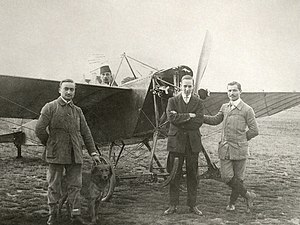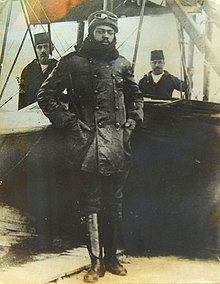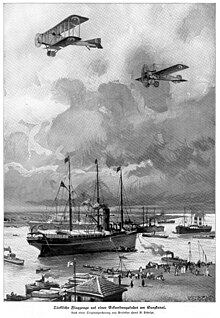Ottoman Aviation Squadrons
[5] On 2 December 1909, Louis Blériot and the Belgian pilot Baron Pierre de Caters performed the first flight demonstration in the Ottoman Empire.After witnessing the growing importance of an air combat support branch, the Ottoman government decided to organize its own military aviation program.[citation needed] Although left without any governmental guidelines for establishing an air force, the Ottoman Minister of War of the time, Mahmud Shevket Pasha, continued to encourage the idea of a military aviation program.On 28 June 1911, a written examination was held and on 4 July, Cavalry Captain Mehmet Fesa (Evrensev) and Engineer Lieutenant Yusuf Kenan were selected.[6] In late 1911 Staff Lieutenant Colonel Süreyya (İlmen) was entrusted with founding the Aircraft Committee (Tayyare Komisyonu) with members from the Inspectorate of Technical and Fortified Formations (Kıtaât-ı Fenniyye ve Mevâki-i Müstahkeme Müfettişligi).[7] Two tent hangars for the Aircraft School (Tayyare Mektebi) were erected in January 1912 at Yeşilköy, west of Istanbul[8] (which is the Atatürk International Airport today.)On 21 February 1912, Mehmet Fesa and Yusuf Kenan completed their flight training at the Blériot School and returned home with the 780th and 797th French Aero Club certificates.The founding of the Aircraft School quickened advancement in the military aviation program, increased the number of enlisted persons within it, and gave the new pilots an active role in the Ottoman forces.[citation needed] In 1911, the Kingdom of Italy invaded the Tripolitania Vilayet (modern day Libya) of the Ottoman Empire, using aircraft for reconnaissance and bombing missions for the first time in aviation history (on 23 October 1911, an Italian pilot flew over Ottoman lines for reconnaissance; and the next day Italian dirigibles dropped bombs on ground targets, both of which represented the first effective use of aircraft in combat.)[14] The first team's aircraft, a Blériot XI, crashed on 27 February on the flight leg from Damascus to Jerusalem at Al-Samra near the Sea of Galilee, killing pilot Navy Lieutenant (Ottoman Turkish: Bahriye Yüzbaşısı) Fethi Bey and his navigator, Artillery First Lieutenant (Ottoman Turkish: Topçu Mülazım-ı Ula) Sadık Bey.The Ottoman aviation squadrons began World War I under direct control of the Office of the Supreme Military Command (Başkomutanlık Vekâleti).By the war's end, the Ottoman aviation squadrons had become a potpourri of about 200 supplied, purchased, and captured aircraft from Germany, France, Russia, and Britain.[16] It was Erich Serno who convinced the Ottoman military leadership to give the pilots a distinct uniform (a winged crescent and star on their hats.The Ottoman forces, lacking the information to fend off Allenby's offensives around Megiddo, found themselves under heavy air attack while retreating from their rout.
















Aircraft pilotsMilitary of theOttoman EmpireClassical armyKapıkuluJanissariesSix Divisions of CavalrySipahiVoynuksYamaksDervendjisSekbanSeymenSeimeniAkinjiLevendTimariotsHumbaracıBashi-bazoukMartolosArnautReform periodNizam-i DjedidSekban-i DjedidAuspicious IncidentMansure ArmyHamidiehModern armyImperial ArsenalKapudan PashasVecihi HürkuşAhmet Ali ÇeliktenEuropeanByzantineBulgarianSerbianMoldavianHungarianVenetianAlbanianCroatianPolishPortugueseHabsburgRussianWallachiaPersianAfricaSieges and landingsRebellionsConscriptionOttoman ArmyArmistice of MudrospilotsairplanecompaniesseaplaneMahmud Shevket PashaAfro TurkYeşilköyMehmet Fesa EvrensevLouis BlériotPierre de CatersÉtampesAtatürk International AirportFranceConstantinopleDeperdussinBleriot XI-bRobert Esnault-PelterieSultan Mehmed V ReshadItalo-Turkish WarKingdom of ItalyTripolitania Vilayetdirigiblesde jureOttoman provinces of Egypt and SudanUrabi RevoltAlgeriaBalkan WarsFirst Balkan WarMontenegroSerbiaBulgariaGreeceBalkan LeagueSecond Balkan WarEastern ThraceAdrianoplecoup d'étatFirst World WarAl-SamraSea of MarmaraOttoman navalgovernment of the Ottoman EmpireAlexandriaHagios StefanosBlériot XIDamascusJerusalemSea of GalileeOttoman TurkishArtilleryFirst LieutenantDeperdussin BMediterranean SeaSecond Lieutenantmemorial monumentIstanbulOttoman NavyHalberstadt D.IIIHans Joachim BuddeckeGermanyAlbatrosFokkersGothasRumplerCaudronLVG B seriesHalberstadtsPfalzesVoisinsde HavillandsNieuportsBristol ScoutFarman